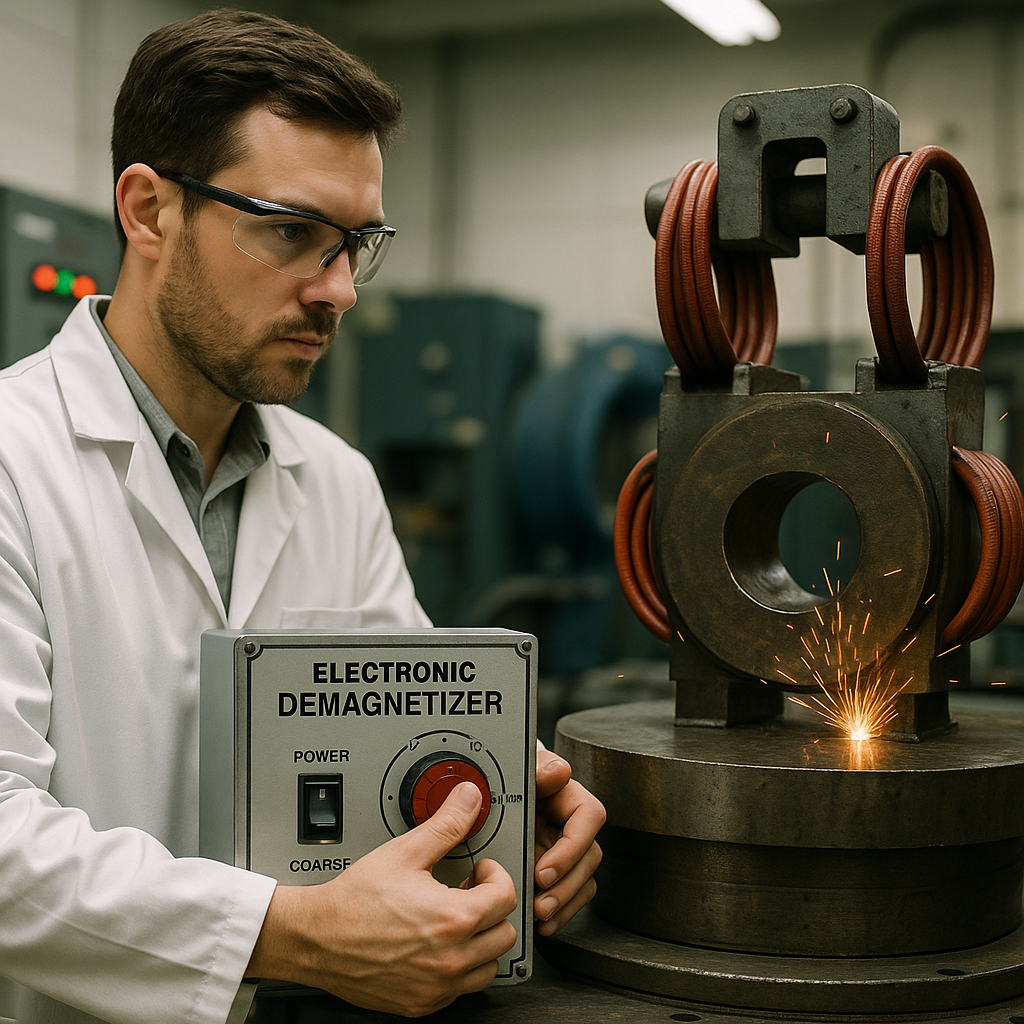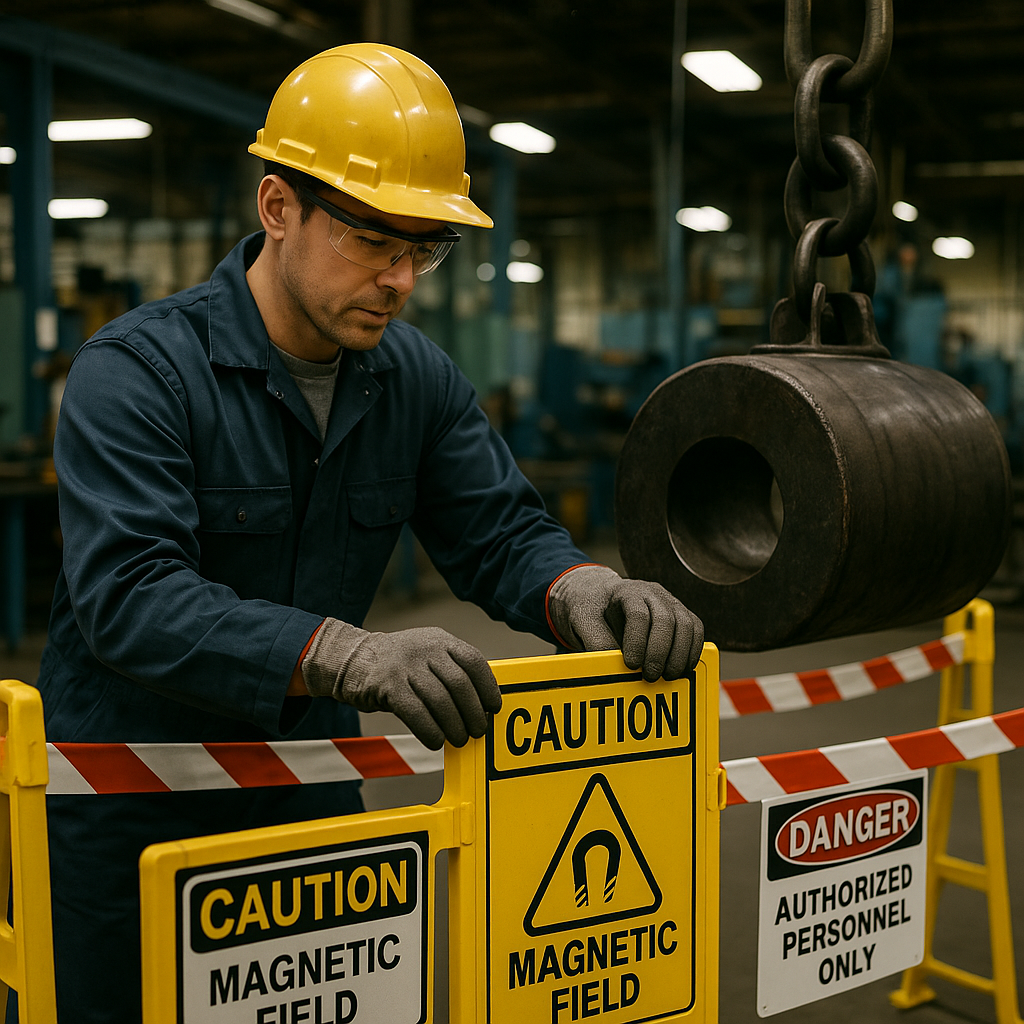5901 Botham Jean Blvd, Dallas, TX 75215
Demagnetizing a Large Magnet: Learn the Process and Precautions
July 25, 2025Degaussing or demagnetizing a large magnet involves reducing, removing, or eliminating its magnetic field. When the magnetic domains inside a magnet become randomly aligned rather than pointing in the same direction, the magnet loses its magnetic properties. This process is particularly important for large, powerful magnets that can interfere with electronic devices, disrupt sensitive equipment, or require safe disposal.
Large magnets present unique challenges in demagnetization. Their strong magnetic fields necessitate specialized techniques beyond those used for smaller magnets. Industrial facilities often need to demagnetize large magnets to repurpose equipment, prevent magnetic interference in manufacturing processes, or handle magnetic waste materials safely.
The strength of a large magnet’s field can pose safety risks and practical problems when uncontrolled. For instance, a powerful magnet can attract metal objects from significant distances, potentially causing injuries or damaging sensitive electronics. Effective demagnetization offers a solution to manage these risks while handling or disposing of large magnetic materials.
What Are the Main Methods for Demagnetizing Large Magnets?

Large magnets can be demagnetized through several effective methods when their magnetic properties need to be reduced or eliminated. Each technique works by disrupting the alignment of magnetic domains within the material.
Heating Method
Heating a magnet to its Curie temperature is one of the most reliable demagnetization methods. When heated sufficiently, the thermal energy causes the magnetic domains to lose their alignment, eliminating the magnetic field.
Different magnetic materials have different temperature thresholds. For example, hard ferrite magnets typically require temperatures above 450°C to demagnetize completely. This method is particularly effective for rare earth magnets like neodymium, though it may slightly weaken their material properties if they need to be remagnetized later.
Alternating Current (AC) Magnetic Field
Using an alternating current to create a fluctuating magnetic field is another common demagnetization technique. The process involves passing AC through a coil placed near the magnet, generating a magnetic field that counteracts the magnet’s own field.
For optimal results, the AC field starts strong and gradually decreases in strength. This method works well for demagnetizing large objects like motors and generators, creating a fine domain structure from inside to outside of the material.
Using Powerful Electromagnets
Electromagnets can generate magnetic fields strong enough to demagnetize large magnets. This technique involves creating a powerful AC current through an electromagnet coil, producing a field that disrupts the alignment of magnetic domains in the target magnet.
The effectiveness depends on generating field strengths appropriate for the specific magnetic material. For AlNiCo magnets, field strengths of 350 kA/m can achieve complete demagnetization, while hard ferrite materials may require over 800 kA/m.
Reversing the Magnetic Field
This method, also known as knockdown demagnetization, involves applying a magnetic field with polarity opposite to the magnet’s own field. The opposing field cancels out the original magnetism, reducing its strength.
The field must be metered precisely to ensure the magnetism in the component jumps to near-zero. This technique can be particularly useful for specific applications where other methods might be impractical.
| Demagnetization Method | Description | Magnetic Materials |
|---|---|---|
| Heating to Curie Temperature | Involves heating a magnet to a temperature where thermal energy disrupts domain alignment, effectively eliminating the magnetic field. | Rare earth magnets like neodymium and hard ferrite. |
| Alternating Current (AC) Magnetic Field | Uses a fluctuating magnetic field via AC through a coil, gradually reducing the magnet’s field strength. | Effective for large objects like motors and generators. |
| Using Powerful Electromagnets | Involves generating strong AC currents through electromagnet coils to disrupt domain alignment in the magnet. | AlNiCo and hard ferrite materials. |
| Reversing the Magnetic Field | Applies an opposing magnetic field to cancel out existing magnetism. | Specific applications where precise demagnetization is needed. |
Mechanical Demagnetization
Though less reliable for large magnets, applying mechanical force through striking or vibration can cause slight reductions in magnetization. The impact disrupts the alignment of magnetic domains, weakening the field.
This method is generally not recommended for valuable magnets as it can cause physical damage and provides less predictable results compared to other techniques.
How Does Pulse Demagnetization Work for Large Magnets?

Pulse demagnetization is a notable advancement in magnetic field technology, especially for managing large magnets and assemblies. Unlike traditional methods, the pulse technique applies a controlled, high-strength magnetic field in a precise sequence, effectively neutralizing magnetism in substantial objects.
The process starts with a powerful magnetic pulse that quickly reaches maximum field strength. This initial surge aligns all magnetic domains within the material, even those deep inside large magnets. The field strength typically falls between 50-100 kA/m, providing enough power to penetrate materials up to 60mm thick.
After achieving maximum strength, the system controls the decreasing alternating field precisely. This controlled decay occurs monotonically, following a consistent reduction pattern without irregular fluctuations. This precision is crucial–small irregularities during the decay phase can disrupt the necessary random distribution of magnetic domains for complete demagnetization.
Consider pulse demagnetization like calming a crowded room. First, you get everyone’s attention with a loud sound (maximum field strength), then gradually lower your voice in a consistent pattern until silence is achieved. If your volume changes erratically, people remain agitated rather than settling.
The Maurer Degaussing® technology enhances this process with several innovations. Its Constant Field Technology (CFT®) maintains consistent field strength regardless of the demagnetizing coil’s fullness, ensuring reliable performance even with large or irregularly shaped magnets.
For large magnets and assemblies, the system operates at lower frequencies between 1-8 Hz. This slower frequency allows better penetration depth, ensuring the magnetic field reaches the core of large objects. The process typically lasts between 6-20 seconds per pulse, making it remarkably efficient compared to conventional methods.
A significant advantage of pulse demagnetization is the ability to demagnetize assembled components without disassembly. For instance, cutting dies can be demagnetized without dismantling, saving time and preserving precise settings. Large washing baskets filled with bulk materials can be demagnetized in seconds, drastically improving productivity.
The technology also resolves a common inefficiency in traditional systems, which consume significant reactive power that dissipates ineffectively. The Maurer Degaussing® procedure compensates for this reactive power and converts most of the energy into active power, resulting in much higher efficiency.
For exceptionally large or bulky objects, specialized universal pulses with wide frequency bands are employed, making pulse demagnetization suitable for a wide range of industrial applications where large magnetic components must be efficiently processed.
| Pulse Method | Maximum Field Strength (kA/m) | Frequency (Hz) | Pulse Duration (s) | Object Size Description |
| Pulse Demagnetization | 50-100 | 1-8 | 6-20 | Suitable for thick materials up to 60mm |
| High Intensity Sine Pulse | 50-100 | 5-20 | 6-20 | Large surface steel objects |
Field symmetry during the discharge phase is another critical factor. Small symmetrical deviations between north and south poles can cause residual magnetism. Advanced systems address this by shielding components from external magnetic fields, such as Earth’s magnetic field, particularly important when demagnetizing long components or bulk materials.
What Safety Precautions Should Be Taken When Demagnetizing Large Magnets?

Demagnetizing large magnets, particularly powerful neodymium magnets, requires strict safety protocols to prevent injuries and equipment damage. These strong magnets can cause serious harm if mishandled during the demagnetization process.
Personal protective equipment is essential when working with large magnets. Always wear safety glasses to protect your eyes from potential shards if a magnet shatters. Heavy-duty protective gloves are also necessary to prevent pinching injuries, as the strong attractive forces can easily trap fingers and cause severe contusions or even broken bones.
Essential Safety Gear and Preparation
Before beginning any demagnetization procedure, proper preparation is critical. Remove all metal objects from your pockets including keys, coins, and pocket knives. Keep electronic devices like smartphones, credit cards, and medical devices at a safe distance, as strong magnetic fields can damage them or cause malfunctions.
- Always wear safety glasses to protect against potential flying fragments
- Use heavy-duty protective gloves to prevent pinching injuries
- Empty pockets of all metal items before handling magnets
- Keep electronic devices and magnetic media at least several feet away
- Work on a non-magnetic surface (wood or plastic) without steel components
Proper Handling Techniques
When handling large magnets for demagnetization, never allow them to slam together. The brittle nature of neodymium magnets means they can shatter upon impact, sending sharp metal fragments flying at high speeds. Use non-metallic tools like plastic wedges to separate magnets instead of using your hands.
Maintain safe distances between individual magnets to prevent sudden collisions. Store large magnets at least one meter away from your body, and separate them with pieces of cardboard when not in use.
Demagnetization Process Safety
The demagnetization process itself presents several unique hazards. When using thermal demagnetization methods, be aware that neodymium magnets can lose their magnetic properties at high temperatures (above 175°F or 80°C) but may also catch fire and produce toxic fumes at excessive temperatures.
For large magnets, the most effective demagnetization often uses specialized equipment that generates high-intensity sine pulse demagnetization. This equipment should be operated with caution as it creates strong magnetic fields and requires significant electrical power.
- Ensure proper ventilation when using thermal demagnetization methods
- Maintain a clear working area with no bystanders during the process
- Follow equipment manufacturer guidelines for power requirements
- Use specialized equipment with appropriate pulse parameters (5-20Hz frequency)
- Allow sufficient cooling time after thermal demagnetization before handling
For very large or industrial-scale magnets, professional assistance is strongly recommended. Specialized demagnetization services have the proper equipment and expertise to safely handle powerful magnets without risking injury or property damage.
Environmental Considerations
Proper disposal is an important safety consideration when demagnetizing large magnets. Neodymium magnets should be placed in steel containers before disposal to prevent them from attracting waste disposal equipment. All strong permanent magnets should undergo thermal demagnetization before disposal.
When possible, recycle neodymium magnets through facilities that specialize in rare earth materials. This reduces environmental impact and conserves valuable resources.
By following these comprehensive safety protocols, the risks associated with demagnetizing large magnets can be significantly reduced. The process requires patience, proper equipment, and careful attention to detail to ensure both personal safety and successful demagnetization.
Conclusion: Choosing the Right Demagnetization Method

Choosing the right method to demagnetize a large magnet depends on several important factors, including the magnet’s material composition, size, and intended use after demagnetization. While heating to the Curie temperature or using mechanical impact might be suitable for smaller magnets, large industrial magnets require specialized techniques that consider field strength, frequency, and safety.
The most effective methods for large-scale demagnetization typically involve high-intensity pulse demagnetization systems or specialized degaussing equipment. These systems generate controlled alternating magnetic fields strong enough to counteract the significant coercive forces in large magnets, ensuring uniform demagnetization throughout the material. For your recycling and materials recovery needs concerning large magnetic components, contact Okon Recycling at 214-717-4083.
